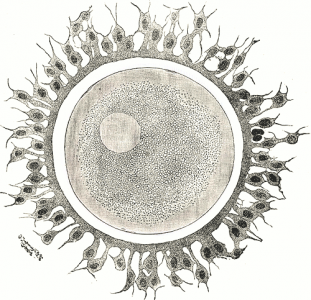Oocyte II definition
Oocyte designates a female germline diploid cell that forms during the cycle called oogenesis and derives from oogonium growth. In mammals and most species, oocyte II is a haploid cell derived from the maturation of oocyte I in oogenesis.
Oocyte II development
At the end of meiosis phase I, in oogenesis, oocyte I gives rise to two unequal haploid cells: one very large, oocyte II (figure 1) and the other very small, the first polar globule. The latter degenerates but oocyte II advances in meiosis cycle until it is interrupted in metaphase II, where it remains until fertilization. It is as oocyte II that the oocyte is release from the ovary.

Figure I – Human oocyte II after being released from the ovary. Around it has a layer of cells called corona radiata.
Cdk1/Cyclic B complex is responsible for meiosis interruption in oocytes II. In turn, activity of this complex is controlled by a cytostatic factor (CSF). This factor leads to disruption in metaphase II through control of several pathways, such as MAP kinase (MAPK) pathway, and mitotic inhibitor 2 (Emi2) pathway. On one hand, MAPK pathway is mainly involved in maintaining oocyte suspended in metaphase II; on the other hand, Emi2 pathway, has a dual role, both in causing cessation of meiosis and in maintaining oocyte II suspended in metaphase II. In order for meiosis to stop, MAPK pathway and Cdk1/Cyclic B kinase complex must have increased activity.
At the time of fertilization and to enable the release of metaphase II (and consequent advancement in meiosis cycle), it is necessary to have high Ca2+ levels, which will lead to activation of a calmodulin-dependent protein kinase II (CaMKII). Activation of CaMKII leads to degradation of Emi2 and Cdk1/Cyclic B kinase complex (among other proteins), which, consequently, will allow separation of sister chromatids and lead to progression in meiosis.
At the end of meiosis, oocyte II gives rise to two unequal cells: one quite large, the mature ovum, and another small, the second polar body.
References:
Abrieu A., Dorée M., Fisher D. (2001). The interplay between cyclin-B–Cdc2 kinase (MPF) and MAP kinase during maturation of oocytes. Journal of Cell Science 114, 257-267. The Company of Biologists Ltd.
Gilbert S. F. (2013). Developmental Biology (10ª edição). Sinauer Associates, Inc., Sunderland (MA).
Von Stetina, J. R., & Orr-Weaver, T. L. (October de 2011). Developmental Control of Oocyte Maturation and Egg Activation in Metazoan Models. Cold Spring Harb Perspect Biology, 3(10), 19




